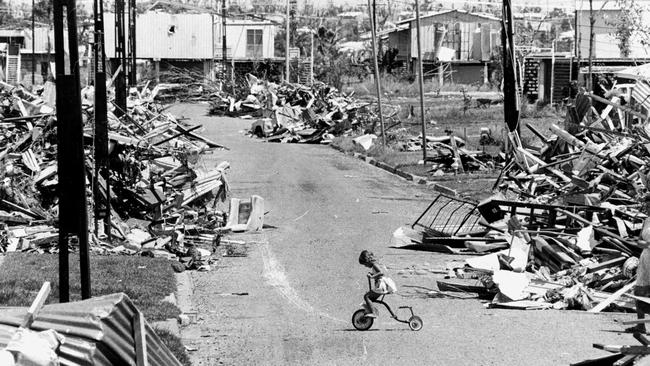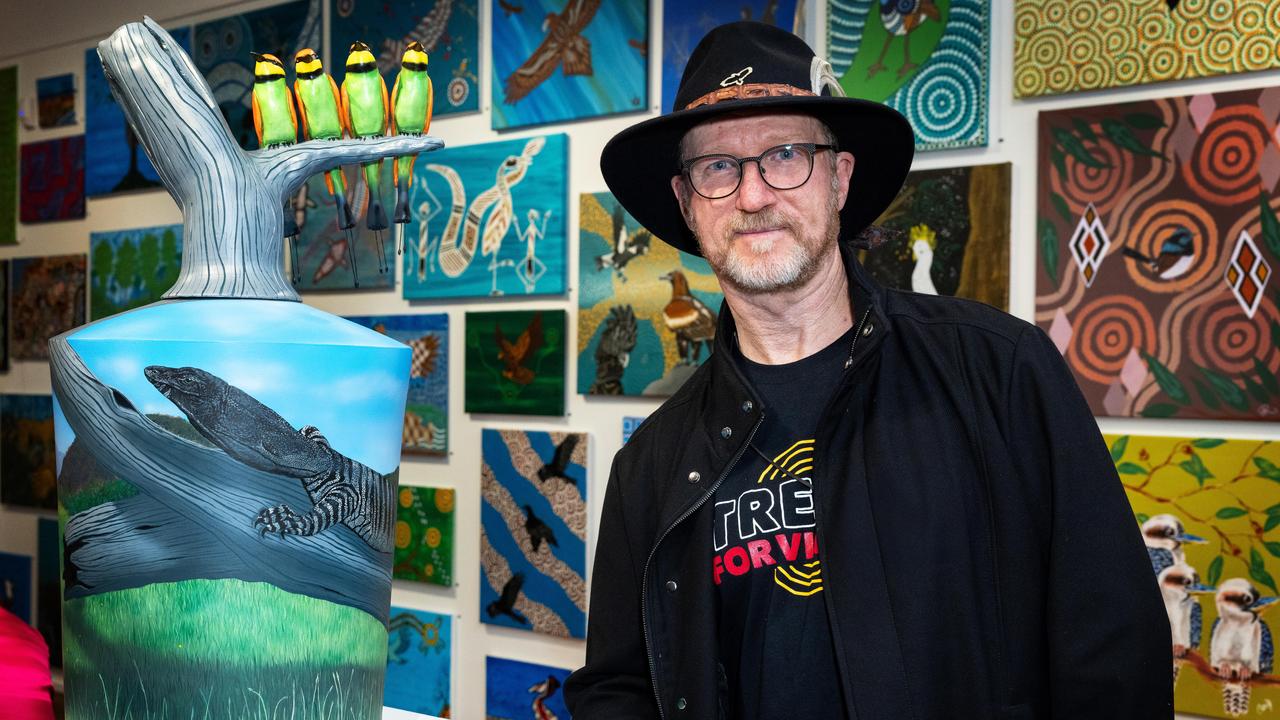Blown away by the impact of Cyclone Tracy on Darwin
AS the 40th anniversary of Cyclone Tracy approaches, a new book revisits the day a city disappeared.

IT’S a steamy tropical night. The sky is glowing slightly, an eerie green. There is lightning all around and the wind is wild. Bernard Briec is only 10 and has lived in Darwin for five years; Colleen D’Arcy is 43 and has been in the Territory for 30. They are singing together in the St Mary’s Cathedral choir, to celebrate midnight mass on Christmas Eve. This is a modern church, built in 1962 using white stone carved from local cliffs. It has the light-filled simplicity typical of tropical churches and there are louvres set high among the eaves.
Bernard and Colleen find they are having to sing louder than usual this evening, straining to make their voices heard over the shriek of the wind, the pelting rain, the restless congregation. Colleen nearly didn’t make it into the church at all. The wind buffeting her VW Beetle made it almost impossible to open, then close, its doors once she arrived. Bernard was already there, standing at the back. Too small to see over the balcony, he could still tell things were amiss.
Soon the power went out and the organ fell silent. There were gasps and murmurs, but the choir kept singing. Nuns moved quickly to fetch candles. The flickering flames were pretty, adding to the atmosphere, but the wind kept blowing them out. Then there was the crash of the high louvres exploding, the tinkle of glass falling to the ground.
Bishop John O’Loughlin, who’d become increasingly unsure about the wisdom of holding mass at all, rapidly wound things up. ‘‘Go home,’’ he said, ‘‘and look after yourselves.’’
Another priest, Ted Collins, left the church but was soon forced to take shelter in St John’s College, where he made a recording of the wind, the wild scraping of corrugated iron. St Mary’s survived the night (so did the tape), but its sister cathedral, Christ Church, was reduced to rubble less than an hour after midnight mass was called to a close. All that was left of that stone church, which dated from 1917, was a porch.
Getting home was no easy task. Colleen headed off in her Beetle, while Bernard, who was with family and friends, took off in a convoy of cars that headed for Myilly Point just down the road. This was where most senior public servants lived, high on the cliffs in houses on stilts that looked out over the Arafura Sea. The group stopped briefly so a friend could nick into his house to grab a camera, but getting in and out of the house seemed to take him forever.
It also took a very long time to drive the 10km to the suburb of Moil because the rain was so heavy Bernard’s dad couldn’t see out the windscreen. He steered by hugging the gutter the whole way, hitting it lightly from time to time and allowing it to nudge him in the right direction. It was very late when they got to the house where the party was. But they were celebrating Christmas in the European style, and Christmas Eve was the big night, so the kids ran around the house and everyone ate.
The wind and rain got wilder all the while. When things became so loud that it seemed time to find cover, everyone headed for the bathroom: semi-regular cyclone warnings had emphasised that the smallest rooms were the strongest. When they opened the bathroom door they saw a wall of the bathroom had vanished. Their host assured them that the garage he’d just built was safe, so that’s where they tried next. They opened the door to the garage to find that, too, had blown away.
MY childhood in Melbourne was defined, in part, by the build-up to Christmas Day and the long summers that followed it. But I can’t remember much of what actually happened most Christmas days and I certainly can’t remember what I was doing on Christmas Eve 1974.
I was the same age as Bernard Briec, which means a bit too old to want to catch Santa in the act, but young enough to feel the thrill of impending presents. I know my parents would have tried to get me to bed early to compensate somehow for the fact I’d be waking at dawn. I would have been in my bed for several hours by the time Bernard squeezed under a bed with four women and numerous children in an attempt to stay safe — unable to move at all because they were so tightly squeezed together that if he rolled, he’d squash the baby that was jammed up against him.
The rain was coming in everywhere, then he heard men shouting, ‘‘The roof is gone’’, and one of the boys under the bed with him started yelling, ‘‘We’re all going to die.’’ The sound of the thunder was constant, the sky was roaring.
While my mum and dad were drinking a claret or three and wrapping our presents, Bernard’s dad probably watched what Bernard reckons must have been half of Darwin flying overhead. But he doesn’t know, he’ll never know, because his father won’t talk about it. For 20 years (it was 20 years later that Bernard told his tale) his father wouldn’t speak of what happened that night. It was, Bernard said to Francis Good, the man who interviewed him in 1994, the longest night of his life. It wasn’t till dawn — around the time I was jumping on my parents to wake them up — that Bernard was allowed to crawl out from under the bed. When he saw what remained of Darwin it seemed as if a nuclear blast had hit the city. He thought everyone other than his family and friends must be dead. He thought his world had ended.
Now this I can remember as clearly as if it were yesterday: on Boxing Day 1974, which was my 11th birthday, I walked down the driveway of my suburban Melbourne home to pick up the paper. The Age, tightly rolled to get it in the mail slot, took a minute or so to open out. Once I’d managed it, I stood trying to make sense of the photo before me: an image, from almost 4000km to the north, of flattened piles of rubble and twisted pieces of corrugated iron.
That photo has haunted me to such an extent that here I am, publishing a book about the disaster almost 40 years later. I can’t tell you why it shocked me so deeply, but it was to do with Cyclone Tracy hitting at Christmas — Christmas — and all those kids missing out on their toys. It was also to do with the realisation that a city could do what Darwin did. It could disappear overnight.
But despite the powerful effect that image had on me, when I returned to those newspapers — on microfiche, in Victoria’s State Library — 38 years later, I found my recollection was incorrect. The cover of The Age that Boxing Day was not a photo but an illustration of a map of Australia with a satellite photo laid over it, so we could see Cyclone Tracy’s dense swirls hovering off Australia’s northern coast. The photo that I remember was on the cover of The Age two days later, on Saturday December 28, 1974. Memory is a slippery thing.
THESE are the bare bones of it: around midnight on Christmas Eve 1974, a cyclone hit Darwin. Around 71 people died, hundreds more were injured and 70 per cent of the homes of Darwin’s 47,000 inhabitants were laid waste. That left only 500 residences habitable out of 12,000. Every single public building was destroyed or seriously damaged. While the loss of life was limited, the material damage was unparalleled. The population of Darwin endured winds that some believe reached 300km/h. In the week after Tracy, close to 30,000 people were flown out of the ruined town in what remains Australia’s biggest evacuation effort. Many of them never returned.
The damage bill has been estimated at between $800 million and $1.3 billion, which is the equivalent of $6.1bn today. This, set against the town’s relatively small population, means it still ranks as one of the world’s most costly disasters.
The damage was contained, comprehensive and explicitly material: Tracy wiped out a city. Perhaps this is why it has become Australia’s most iconic catastrophe, even if not its worst. When floodwaters swamped the Queensland town of Grantham on January 10, 2011, Tracy was the first point of reference. Paul Lockyer, the ABC journalist who arrived in the town the morning after the deluge hit, stood in the rain surrounded by swirling water and debris and said: “My best parallel comparison would be Cyclone Tracy 1974. The houses here are better built than they were in Darwin but this wall of water that’s come down from Toowoomba and lightning just striking over me now is, had caused, there’s some thunder, has caused as much damage as Cyclone Tracy did to that community I can tell you … And a bit like Cyclone Tracy when day dawned on Christmas Day in 1975 (sic) we waited for the worst and that’s what’s going to happen here, I fear.’’
I DON’T know exactly what I expected to find on the second floor of a fairly drab green brick building in Cavenagh Street, Darwin, when I arrived back in the dry season of 2011. That is where the Northern Territory Archives lived back then, and I was running late for my appointment with an archivist. Parking in the centre of Darwin was nightmarish but parking a long way away means you turn up for meetings red-faced and sweaty. Francoise Barr, the archivist who I was to meet, was elegance itself. A French woman who’s lived in Darwin for 34 years, she had the job of helping me trawl through all the listings and to figure out where I could start. She sat me down at the computer and off I went.
There were dozens of government reports, of personal collections of photos and clippings. Boxes piled high could have been (and were) brought to me on a trolley for weeks on end. There were hundreds of oral histories and I started ordering them up in impossible numbers.
I read people such as Richard Creswick, Hedley Beare, Bill Wilson and Curly Nixon, I met Colleen D’Arcy and Bernard Briec. These people, who now feel like friends, brought the cyclone and all that followed alive for me. My debt to all the interview participants, and to the Northern Territory Archives, is immense.
It was towards the end of that first visit that Francoise suggested I look at the Commissioner of Police reports written by officers about their experiences. These reports had been commissioned in case there were questions about the ability of the police to do their work in the days and weeks that followed. And it was there, in the plain, blunt, unemotional language of men such as Detective Sergeant Thomas Baker, that I really got a sense of what it might have been like for the people of Darwin. These reports, unadorned and ungrafted, had cyclonic force:
On opening the bathroom door, I saw that the roof was off that part of the house and when I opened the door the ceiling of the room also disappeared; we then went to the toilet which was next door to the bathroom and as I opened the door, I saw the outside wall of the toilet disappear; I then went to the main bedroom of the house and saw that the outside wall had disappeared and that the side walls of the room were moving under the pressure of the wind … My wife and I attempted to hold the bathroom and toilet doors shut and we placed our two children between our bodies to protect them.
And that, in short, is what happened. People confronted an unimaginable force of nature with only their bodies to protect themselves and their children. Everything else: roofs, furniture, walls, birds, trees, gardens, meaning. All that disappeared.
Notions of apocalypse have nagged away at me for years, exacerbated, perhaps, by a three-month trip to Sri Lanka soon after the South-East Asian tsunami of 2004. Sri Lanka’s ancient cities Polonnaruwa and Anuradhapura have long given mute testimony that cities can indeed rise, then disappear; and of course I was surrounded by more recent signs of devastation. There was much talk about the fact that people who lived by the beach but had only moved there recently hadn’t known how to read the signs: hadn’t known that the moment when the sea collapsed back in on itself, leaving beaches bare and sea life floundering, was when they should run. Instead, racing down the beach to gather up stranded fish, they ran into the mouth of the wave.
After the Black Saturday bushfires in Victoria in 2009, these feelings became even harder to shake. I reread Tracy, a book by Gary McKay published a few years ago. I found myself talking to the mother of a friend about how, at 19, she’d gone to Darwin for a holiday over Christmas in 1974 and ended up sheltering in the wine cellar of the Victoria Hotel with a group of strangers; her sense of bewilderment when she finally emerged. I sought out Neville Barwick for a conversation — Canberra sent him to Darwin shortly after Tracy — and he described to me the way the buildings rattled and rattled as the wind blew until they simply ‘‘unzipped’’.
I read a series of articles by Tony Clifton, essays that described Darwin as the broken-jaw capital of the world, a spoiled and rotten place.
I read Adrian Hyland’s Kinglake-350, a book about those disastrous 2009 bushfires, in which he also wrote of the findings of the 1939 commission into Black Friday. The way in which the lessons learned are forgot once the trauma has passed: “Sometimes, through sheer intelligence or perhaps because of the emotions generated in a jurist who has peered into the abyss, there are flashes of wisdom. Justice Leonard Stretton, who headed the 1939 royal commission, coined one such insight with the comment: ‘They had not lived long enough.’ He meant that his fellow Australians were living in an environment into which they had not had time to evolve … More miles on the clock we well may have, but our cultural awareness of the environment has not kept pace. Some would argue that it is slipping backwards.’’
Quotes leap out at me as if highlighted whenever I read. ‘‘We speak about the weather / because in truth it tells us what is within us,’’ Kevin Brophy told me, in a poem.
In Alexis Wright’s Carpentaria it is the dogs who bear witness to the ruination of human civilisation: “He was met by the bony, hollow-ribbed, abandoned dogs of the town that had run to the hills and back again after the cyclone. Now, having appeared from nowhere, they roamed along streets that no longer existed, searching for their owners. They did not bark or howl. The shock of the cyclone had left them like this: speechless, dumbfounded, unable to crack a bark. Unable to emit a sound out of their wide-opened mouths.’’
But perhaps my biggest motivation is the fact that the human race is transforming the land, the seas and the weather. There are signs of that all around us, and in a country that already tended to extremes of drought, flood and bushfire we are now facing a world where there will be more calamities more often and larger numbers of us will be affected.
There is a line in the Yolngu language of North East Arnhem Land, Wa ngam ngarra marrtji bump ngarra dhuwal, which translates as: ‘‘I create different places as I travel.’’ In another version, the line is: ‘‘I make this place as I go’’, and it is true, we are doing this: we are making this place as we go. I want to understand somehow, what it is we are making.
Sophie Cunningham is a novelist, critic and editor. This is an edited extract from her new book, Warning: The Story of Cyclone Tracy, to be published next week by Text Publishing ($32.99).


